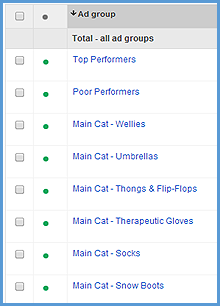
Struggling with Google Shopping's new structure? Our partners at GoDataFeed explain recent changes and 5 Google Shopping bidding strategies for growing your campaign.
If you’ve ever listed your products on Google Shopping, then you already know that it’s an increasingly important shopping engine for driving consumers to your Volusion store. To help you convert your Google Product Listing Ad (PLA) campaigns from the old structure to the new Shopping Campaign structure, the feed management teams at GoDataFeed and Operation ROI have assembled some hands-on tips to make the switch as smooth as possible.
Goodbye Ad Groups, Hello Product Groups
Previously, PLAs allowed you to create ad groups by choosing product attributes from your data feed which gave you a lot of freedom on which ones you could use for your ad groups. Shopping Campaign product groups, on the other hand, don’t build out from your store inventory data feed, but instead segment your inventory for a more streamlined organization. Think of the new product group structure as big buckets that contain smaller buckets. The main product group will be the largest bucket containing smaller buckets for better segmentation and control.
Product Groups are based on any attribute you choose: Brand, Item ID, Custom Label, Product type or Google Product Category. We recommend you begin structuring your product groupings beforehand and utilizing analytics data to ensure the product groups are set for the best possible return on investment.
Custom Labels vs. Adwords Labels
Custom labels are a new requirement for data feeds, replacing AdWords labels used in Product Listing Ad (PLA) campaigns. There are similarities between the feed labels, such as both being used to mark product attributes and build ad groups.
However, Custom Labels limit you to five, (0-4), which, consequently, also limit the number of Product Groups (ad groups) that you can create with AdWords. The benefit of this change is that Custom Labels work in conjunction with the Product Groups to provide you a better way to segment products.
5 Bidding Strategies for Google Shopping Campaigns
There are 5 basic bidding strategies for managing Google Shopping Campaigns. Before you launch the shopping campaigns, it’s best to review your products and think about how best to categorize your products for bidding purposes. Don’t forget to take advantage of the Custom Labels, which will give you the ability to add your own segmentation choices to your feed.
- Category / Brand Based Bidding:
- Performance Based Bidding:
Tip: Prioritize your Bids
Since, by default, the priority is set to “Low” for all campaigns, the ability to give certain campaigns a higher priority allows you to promote higher-performing products. In some cases we have even moved all the campaigns to “Medium” priority, thus enabling merchants to demote underperforming products without removing them completely.
- Price-Point Based Bidding
Tip: Combine Custom Labels
To set up custom labels based on price point and brand in the feed using GoDataFeed , we’ve set the rule for Custom Label “0” products to include all Nike Shoes that are priced higher than $85 (see example to the left).
- Margin Based Bidding
If you have margins from 10% to 70%, setting up Ad Groups based on the potential revenue made when the individual products sold. If any margin group is not performing, you can pause it or lower the bid significantly.
- Seasonality Based Bidding
One important reason to segment in this manner, as opposed to removing the seasonal products, is that during the off-months you can still list the products; however decrease the bids significantly to keep your overall ROI in check.
Recap:
While all of these strategies will work well if implemented and monitored, it is important to figure out a good starting strategy prior to launching Google Shopping Campaigns. It is also important to understand Custom Labels, Campaign Priority and how to use Negative Keywords, as all of these tools will help make your campaigns more successful.
Migration Tips:
- Don’t go live with your new Shopping Campaigns while still running legacy PLA Campaigns
- Make sure to keep your data feed fresh and up-to-date with the new feed requirements
- Use consumer-friendly titles, descriptions and images to increase click-through rates; titles can now contain up to 150 characters and descriptions up to 5,000 characters
- Take your time & structure for success: Product Groups and Custom Labels are the building blocks for great performance
GoDataFeed and Operation ROI have co-authored this article to help retailers migrate and optimize bidding strategies for the new Google Shopping Campaign structure. In addition to this post, we have created a more in-depth Google Shopping Campaigns White Paper and co-hosted a joint webinar on the topic; Webinar Recording and Slide Deck, both available online.


















